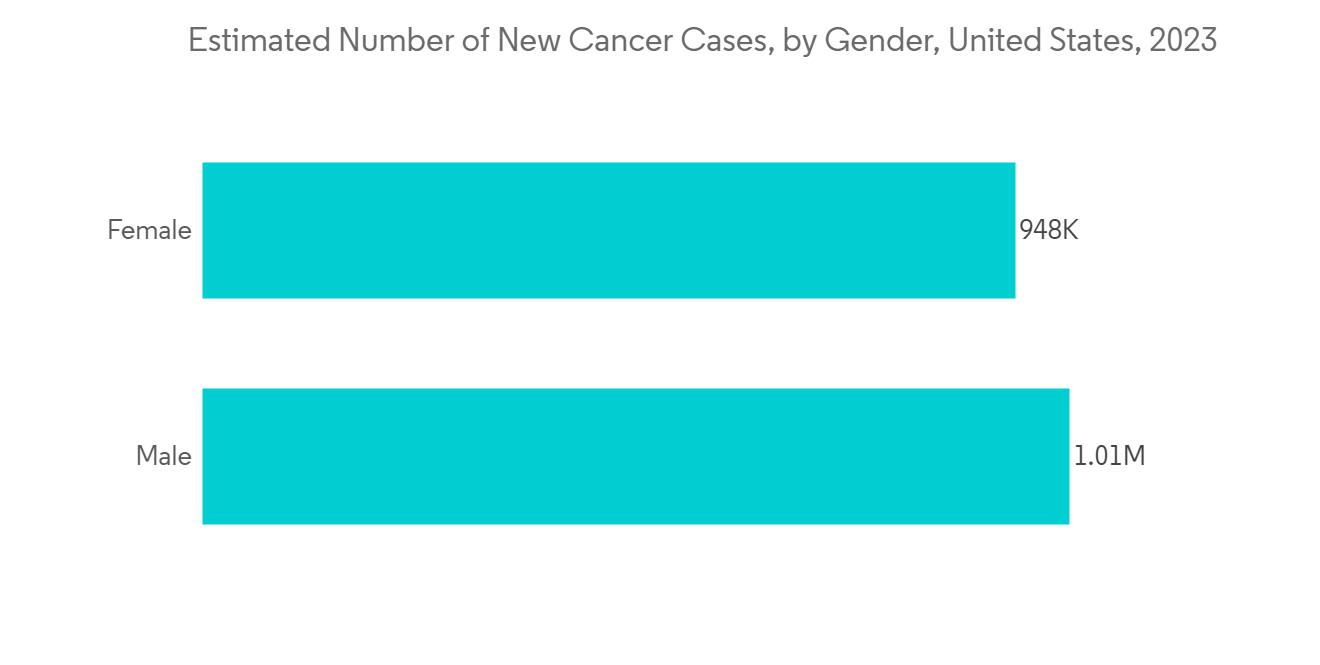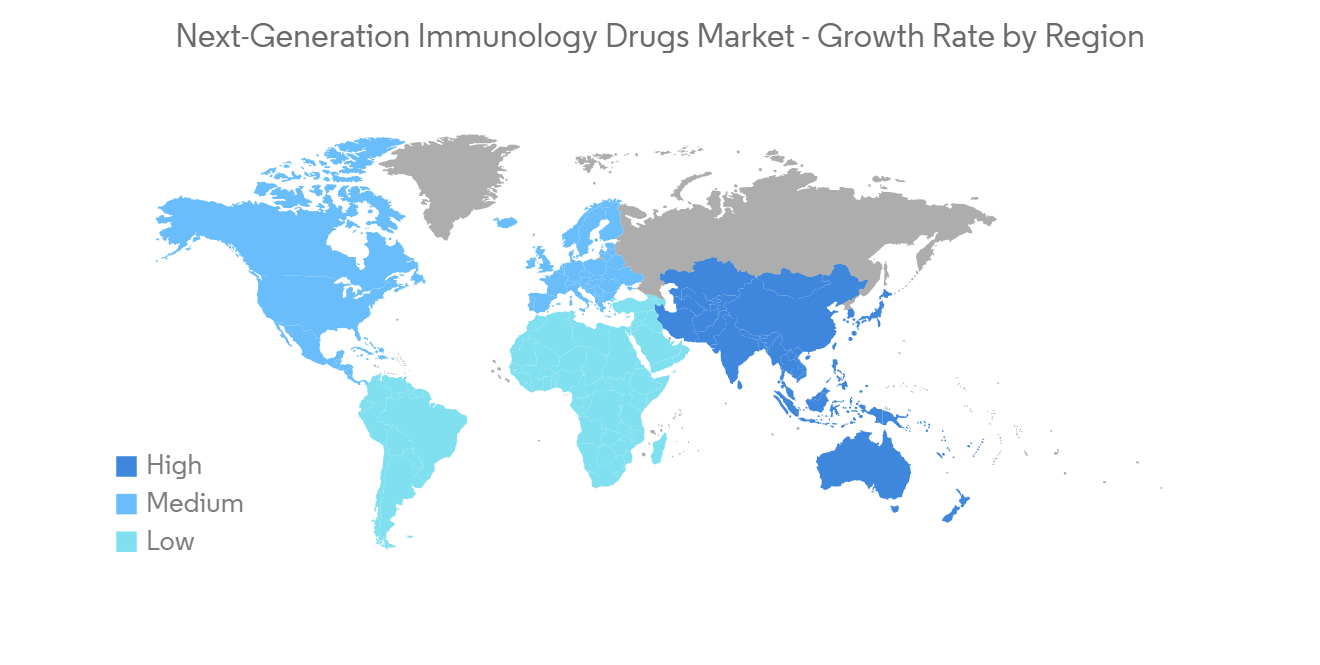 |
市場調査レポート
商品コード
1258776
次世代免疫薬市場- 成長、動向、予測(2023年-2028年)Next-Generation Immunology Drugs Market - Growth, Trends, and Forecasts (2023 - 2028) |
||||||
● お客様のご希望に応じて、既存データの加工や未掲載情報(例:国別セグメント)の追加などの対応が可能です。 詳細はお問い合わせください。
| 次世代免疫薬市場- 成長、動向、予測(2023年-2028年) |
|
出版日: 2023年04月14日
発行: Mordor Intelligence
ページ情報: 英文 130 Pages
納期: 2~3営業日
|
- 全表示
- 概要
- 目次
次世代免疫薬市場は、予測期間中に6.1%のCAGRで推移すると予想されています。
COVID-19のパンデミックは、調査対象となった市場に大きな影響を与えました。パンデミックの間、COVID-19が免疫に及ぼす影響を理解し、その深刻な影響に対処するために、免疫学研究が活発化しました。例えば、オックスフォード大学免疫学ネットワークは、2021年初頭にCOVID-19に関する研究を行い、体液性免疫、ディープフェノタイピング、炎症反応、細胞免疫に焦点を当てました。さらに、パンデミックの間、COVID-19の免疫学的薬剤の分野の調査が増加しました。例えば、JAK阻害剤とBTK阻害剤は、COVID-19を治療するために評価された免疫調節薬でした。GM-CSF阻害剤です。COVID-19病に対抗するための免疫薬に関する研究の高まりが、市場の成長を後押ししました。しかし、現在、市場はパンデミック前の状態に達しており、予測期間中に大きな成長を遂げることが期待されます。
市場成長を促進する主な要因としては、慢性疾患の負担増、次世代医薬品の分野における研究の増加、特定の疾患に対する標的療法への注目の高まりなどが挙げられます。
次世代免疫薬市場は、喘息、アレルギー疾患、がん、多発性硬化症などの慢性疾患の有病率が上昇していることから、健全な成長が期待されています。例えば、米国がん協会の2023年1月の報告書によると、2040年までに、人口増加と高齢化により、世界中で1,630万人以上のがん関連死と2,750万人以上の新規症例が発生すると指摘されています。経済発展途上国では、喫煙、食生活の乱れ、運動不足などの危険因子が蔓延しているため、今後、負担は増加すると思われます。慢性疾患の増加に伴い、製薬会社は研究開発に力を入れ、新薬を開発しており、これが市場の開拓に寄与しています。
さらに、各企業が行っている主要な活動が、市場の成長を支えています。例えば、2022年11月、Human Immunology Biosciences社は、自己免疫疾患とアレルギー疾患の標的治療薬を開発するために1億2,000万米ドルを調達したと発表しました。同社は、ドイツのバイオテクノロジー企業MorphoSysからライセンスを受けたfelzartamabとHIB210と呼ばれる2つの医薬品候補を開発しました。どちらも臨床試験中で、前者は2つの希少な腎臓病を対象とした第2相試験中、後者は第1相試験中です。このような新薬の開発に注力する企業が増えていることから、この市場は大きな成長を遂げると考えられています。しかし、次世代医薬品のコストが高いこと、規制が厳しいことなどは、市場の成長を抑制する要因の1つであると考えられています。
次世代免疫薬の市場動向
がんは予測期間中に大きな成長が見込まれる
世界中でがんの負担が増加していることと、がん治療のための新規治療法の調査が進んでいることが、この分野の成長を促進すると予想されます。免疫療法にはさまざまな形態があり、がんの治療に使用されます。免疫チェックポイント阻害剤、T細胞療法、がんワクチン、免疫システム調整剤などは、免疫療法のいくつかの例です。いくつかのがん種とその後期は、これらの薬で治療されます。リツキサン、ヤーボイ、アドセトリス、ゼヴァリンなどは、広く使用されている免疫療法薬の一部です。
新薬の発売は、セグメントの成長を加速させています。例えば、2022年12月、米国FDAは、KRAS G12C変異の局所進行または転移性非小細胞肺がん(NSCLC)の成人患者に対して、RAS GTPaseファミリー阻害剤であるadagrasib(Krazati、Mirati Therapeutics, Inc)の承認を付与しました。さらに、2022年4月、米国FDAは、一部の進行性メラノーマの治療薬として、2つの免疫療法薬の組み合わせを承認しました。この組み合わせは、レルトリマブとニボルマブ(オプジーボ)で構成され、オプドゥアラグという名称で販売される予定です。このようながん治療用免疫薬の発売により、このセグメントは予測期間中に大きな成長を遂げると考えられています。
さらに、大きな懸念事項の1つは、世界のがん負担の増加です。米国、カナダ、英国、インドなどの主要国では、この病気の負担が大きくなっています。例えば、2022年2月に発表されたカナダがん統計報告書のデータによると、2022年にがんと診断される見込みのある人は233,900人であることが判明しています。さらに、同報告書では、乳がん、前立腺がん、大腸がんが最も多いがんであるとしています。これらを合わせると、有病者数のほぼ半分を占めています。カナダのような国では、がん患者の数が多いため、新薬開発のための研究量が増加しており、これがこのセグメントの成長を後押ししています。

予測期間中、北米が最大の市場シェアを占める
北米は、次世代免疫薬にとって極めて重要な市場の一つです。この地域では、製薬研究開発部門が高度に発達しており、市場調査を行っている主要企業が存在することから、米国が大きなシェアを占めると予想されます。
がん患者数の増加は、市場関係者に多大な機会をもたらしています。主要な市場関係者は、新しい信頼性の高い治療法を市場に投入するため、研究開発活動に力を入れています。例えば、2021年3月、米国食品医薬品局はBristol-Myers SquibbとBluebird BioのAbecma(idecabtagene vicleucel)を承認しました。Abecmaは、再発または難治性の多発性骨髄腫の成人患者を治療するために、B細胞成熟抗原(BCMA)を標的とした遺伝子操作による自己T細胞免疫療法です。米国では、各社が新製品を発売していることから、さらなる普及が期待され、同地域の市場成長を促進するものと考えられます。
さらに、次世代医薬品の分野における新製品の発売が、市場の成長を後押ししています。例えば、2022年5月、ノバルティスは、2ライン以上の全身療法後の再発または難治性(r/r)の濾胞性リンパ腫(FL)成人患者の治療薬としてKymriah(tisagenlecleucel)を米国FDAが承認したと発表しました。さらに、2022年4月には、カイトファーマ社が、大細胞型B細胞リンパ腫(LBCL)の成人患者を対象としたアキシカブタジェン・シロロイセル(Yescarta)の製品承認を米国FDAから取得しました。多数の新製品が発売された結果、米国は予測期間中に大きな成長を遂げると予想されます。

次世代免疫薬の業界概要
次世代免疫薬市場は適度な競争があり、複数の主要プレイヤーで構成されています。市場シェアの面では、現在、少数の主要プレイヤーが市場を独占しています。市場競争力を高めるため、各社は新製品の発売、研究開発、事業拡大に力を入れています。市場の主要プレイヤーには、AbbVie Inc.、Amgen Inc.、AstraZeneca、GlaxoSmithKline PLC、Novartis AG、およびF. Hoffmann-La Roche AGが含まれます。
その他の特典:
- エクセル形式の市場予測(ME)シート
- 3ヶ月のアナリストサポート
目次
第1章 イントロダクション
- 調査の前提条件と市場の定義
- 調査対象範囲
第2章 調査手法
第3章 エグゼクティブサマリー
第4章 市場力学
- 市場概要
- 市場促進要因
- 慢性疾患の負担が増える
- 次世代医薬品に関する調査の活発化
- 標的治療薬への注目度が高まる
- 市場抑制要因
- 次世代医薬品の高額なコスト
- 厳しい規制政策
- ポーターのファイブフォース分析
- 新規参入業者の脅威
- 買い手/消費者の交渉力
- 供給企業の交渉力
- 代替品の脅威
- 競争企業間の敵対関係の強さ
第5章 市場セグメンテーション
- 薬効分類別
- 低分子化合物
- 抗体
- 細胞療法
- その他の薬物クラス
- 治療領域別
- がん
- 自己免疫疾患
- 感染症
- 炎症性疾患
- その他の治療分野
- 地域
- 北米
- 米国
- カナダ
- メキシコ
- 欧州
- ドイツ
- 英国
- フランス
- イタリア
- スペイン
- その他欧州
- アジア太平洋地域
- 中国
- 日本
- インド
- オーストラリア
- 韓国
- その他アジア太平洋地域
- 中東・アフリカ地域
- GCC
- 南アフリカ
- その他中東とアフリカ
- 南米
- ブラジル
- アルゼンチン
- その他南米地域
- 北米
第6章 競合情勢について
- 企業プロファイル
- Pfizer Inc
- Abbvie Inc.
- Johnson and Johnson
- F. Hoffmann-La Roche Ltd.
- Amgen Inc.
- Novartis AG
- Astellas Pharma Inc.
- UCB SA
- Bristol-Myers Squibb Company
- Merck & Co., Inc.
- Eli Lilly and Company
第7章 市場機会と今後の動向
The Next-Generation Immunology Drugs Market is expected to register a CAGR of 6.1% over the forecast period.
The COVID-19 pandemic had a significant impact on the market studied. During the pandemic, immunology research was increased to understand the effects of COVID-19 on immunity and cope with the severe effects of the same. For instance, the University of Oxford Immunology Network conducted research on COVID-19 in early 2021 that was focused on humoral immunity, deep phenotyping, the inflammatory response, and cell immunity. Additionally, research in the area of immunology drugs for COVID-19 increased during the pandemic. For instance, JAK and BTK inhibitors were immunomodulatory drugs that were evaluated to treat COVID-19. GM-CSF Inhibitors. The rising research on immunology drugs to combat the COVID-19 disease fueled the market's growth. However, currently, the market has reached its pre-pandemic nature and is expected to witness significant growth over the forecast period.
Some of the key factors propelling market growth include the rising burden of chronic diseases, increasing research in the area of next-generation drugs, and an increased focus on targeted therapies for certain diseases.
The market for next-generation immunology drugs is expected to witness a healthy growth due to the rising prevalence of chronic diseases like asthma, allergic conditions, cancer, and multiple sclerosis. For instance, a January 2023 report from the American Cancer Society indicated that by the year 2040, there will be more than 16.3 million cancer-related deaths and over 27.5 million new cases worldwide due to population growth and aging. The burden will probably increase in the future because risk factors including smoking, eating poorly, and not exercising are becoming more prevalent in economically developing countries. With growing chronic diseases, pharmaceutical companies are focusing more on R&D and developing novel drugs, which is contributing to market growth.
Furthermore, the key activities undertaken by the various companies are supporting market growth. For instance, in November 2022, Human Immunology Biosciences announced that it had raised USD 120 million to develop targeted treatments for autoimmune and allergic diseases. The company developed two drug candidates, called felzartamab and HIB210, that were licensed from the German biotechnology company MorphoSys. Both are in clinical trials, with the former in Phase 2 testing for two rare kidney diseases and the latter in Phase 1. Hence, owing to the increasing focus of companies on developing such novel drugs, it is believed that the market studied is likely to witness strong growth. However, the high cost of next-generation drugs and stringent regulatory policies are some of the factors that are expected to restrain market growth.
Next-Generation Immunology Drugs Market Trends
Cancer is Expected to Witness Significant Growth Over the Forecast Period
The increasing burden of cancer across the globe coupled with the growing research on novel therapies for cancer treatment are expected to fuel the segment's growth. Immunotherapies come in a variety of forms and are used to treat cancer. Immune checkpoint inhibitors, T-cell cell therapy, cancer vaccines, and immune system modulators are a few examples of immunotherapies. Several cancer types and their later stages are treated with these medicines. Rituxan, Yervoy, Adcetris, and Zevalin are a few of the widely used immunotherapy medications.
New drug launches are accelerating segment growth. For instance, in December 2022, the US FDA granted approval to adagrasib (Krazati, Mirati Therapeutics, Inc.), a RAS GTPase family inhibitor, for adult patients with KRAS G12C-mutated locally advanced or metastatic non-small cell lung cancer (NSCLC). Additionally, in April 2022, the US FDA approved a combination of two immunotherapy drugs for the treatment of some people with advanced melanoma. The combination consists of relatlimab and nivolumab (Opdivo) and will be marketed under the name Opdualag. With the launch of such immunology drugs for cancer treatment, the segment is believed to witness significant growth over the forecast period.
Furthermore, one of the major concerns is the rising global cancer burden. Key countries like the United States, Canada, the United Kingdom, and India are experiencing the burden of the disease. For instance, as per the data from the Canadian Cancer Statistics report published in February 2022, it was found that there were 233,900 people expected to be diagnosed with cancer in the year 2022. The report further stated that breast, prostate, and colorectal cancers are the most prevalent cancers. Combined, they account for almost half of all prevalent cases. With the high number of cancer cases in countries like Canada, there is an increasing amount of research for the development of new drugs, which is boosting the segment's growth.

North America to Hold the Largest Market Share Over the Forecast Period
North America is one of the crucial markets for next-generation immunology drugs. In this region, the United States is expected to hold a major share due to its highly developed pharmaceutical R&D sector and the presence of key companies operating in the market studied.
The increasing number of cancer cases is creating tremendous opportunities for market players. The major market players are focusing on R&D activities to launch new and reliable treatments in the market. For instance, in March 2021, the United States Food and Drug Administration approved Bristol-Myers Squibb and Bluebird Bio's Abecma (idecabtagene vicleucel). Abecma is a genetically engineered autologous T cell immunotherapy directed to target the B-cell maturation antigen (BCMA) to treat adult patients with relapsed or refractory multiple myeloma. The rising product launches by the players in the United States lead to further adoption and are thereby expected to propel the market growth in this region.
Additionally, new product launches in the area of next-generation drugs are propelling market growth. For instance, in May 2022, Novartis announced the US FDA's approval of Kymriah (tisagenlecleucel) for the treatment of adult patients with relapsed or refractory (r/r) follicular lymphoma (FL) after two or more lines of systemic therapy. Additionally, in April 2022, Kite Pharma Inc. received product approval from the US FDA for its axicabtagene ciloleucel (Yescarta) for adult patients with large B-cell lymphoma (LBCL). As a result of the numerous new product launches, the United States is expected to experience significant growth during the forecast period.

Next-Generation Immunology Drugs Industry Overview
The next-generation immunology drugs market is moderately competitive and consists of several major players. In terms of market share, few of the major players currently dominate the market. The market players are focusing on new product launches, R&D, and expansions to gain a competitive advantage. Some of the market's major players include AbbVie Inc., Amgen Inc., AstraZeneca, GlaxoSmithKline PLC, Novartis AG, and F. Hoffmann-La Roche AG.
Additional Benefits:
- The market estimate (ME) sheet in Excel format
- 3 months of analyst support
TABLE OF CONTENTS
1 INTRODUCTION
- 1.1 Study Assumptions and Market Definition
- 1.2 Scope of the Study
2 RESEARCH METHODOLOGY
3 EXECUTIVE SUMMARY
4 MARKET DYNAMICS
- 4.1 Market Overview
- 4.2 Market Drivers
- 4.2.1 Rising Burden of Chronic Diseases
- 4.2.2 Increasing Research in the Area of Next Generation Drugs
- 4.2.3 Increasing Focus on Targeted Therapies
- 4.3 Market Restraints
- 4.3.1 High Cost of Next Generation Drugs
- 4.3.2 Stringent Regulatory Policies
- 4.4 Porter's Five Forces Analysis
- 4.4.1 Threat of New Entrants
- 4.4.2 Bargaining Power of Buyers/Consumers
- 4.4.3 Bargaining Power of Suppliers
- 4.4.4 Threat of Substitute Products
- 4.4.5 Intensity of Competitive Rivalry
5 MARKET SEGMENTATION
- 5.1 By Drug Class
- 5.1.1 Small Molecules
- 5.1.2 Antibodies
- 5.1.3 Cell Based Therapies
- 5.1.4 Other Drug Classes
- 5.2 By Therapeutic Area
- 5.2.1 Cancer
- 5.2.2 Autoimmune Diseases
- 5.2.3 Infectious Diseases
- 5.2.4 Inflammatory Diseases
- 5.2.5 Other Therapeutic Areas
- 5.3 Geography
- 5.3.1 North America
- 5.3.1.1 United States
- 5.3.1.2 Canada
- 5.3.1.3 Mexico
- 5.3.2 Europe
- 5.3.2.1 Germany
- 5.3.2.2 United Kingdom
- 5.3.2.3 France
- 5.3.2.4 Italy
- 5.3.2.5 Spain
- 5.3.2.6 Rest of Europe
- 5.3.3 Asia-Pacific
- 5.3.3.1 China
- 5.3.3.2 Japan
- 5.3.3.3 India
- 5.3.3.4 Australia
- 5.3.3.5 South Korea
- 5.3.3.6 Rest of Asia-Pacific
- 5.3.4 Middle East and Africa
- 5.3.4.1 GCC
- 5.3.4.2 South Africa
- 5.3.4.3 Rest of Middle East and Africa
- 5.3.5 South America
- 5.3.5.1 Brazil
- 5.3.5.2 Argentina
- 5.3.5.3 Rest of South America
- 5.3.1 North America
6 COMPETITIVE LANDSCAPE
- 6.1 Company Profiles
- 6.1.1 Pfizer Inc
- 6.1.2 Abbvie Inc.
- 6.1.3 Johnson and Johnson
- 6.1.4 F. Hoffmann-La Roche Ltd.
- 6.1.5 Amgen Inc.
- 6.1.6 Novartis AG
- 6.1.7 Astellas Pharma Inc.
- 6.1.8 UCB SA
- 6.1.9 Bristol-Myers Squibb Company
- 6.1.10 Merck & Co., Inc.
- 6.1.11 Eli Lilly and Company
